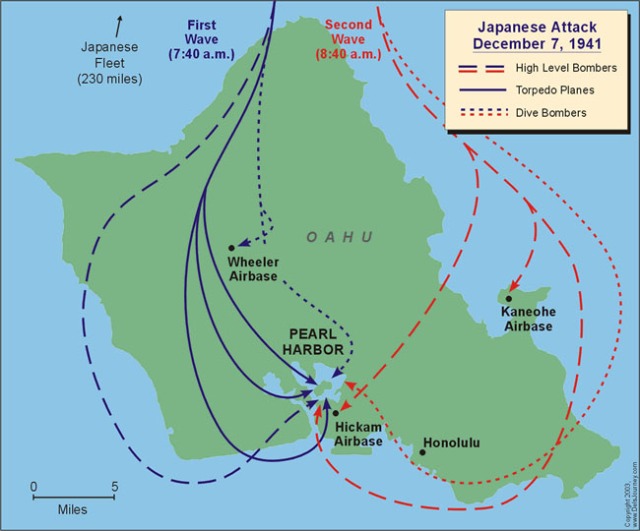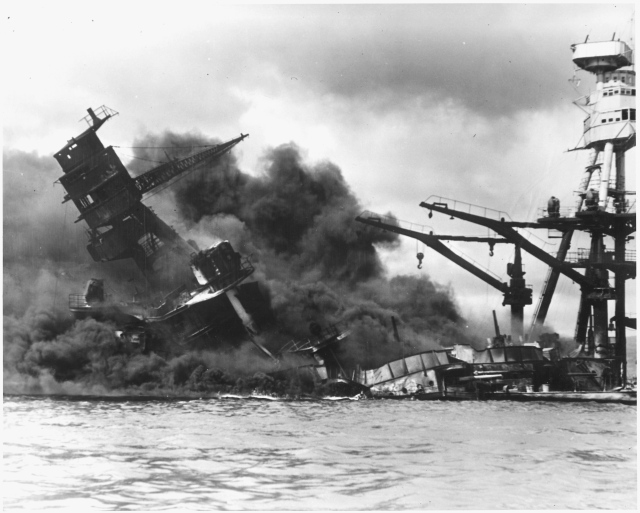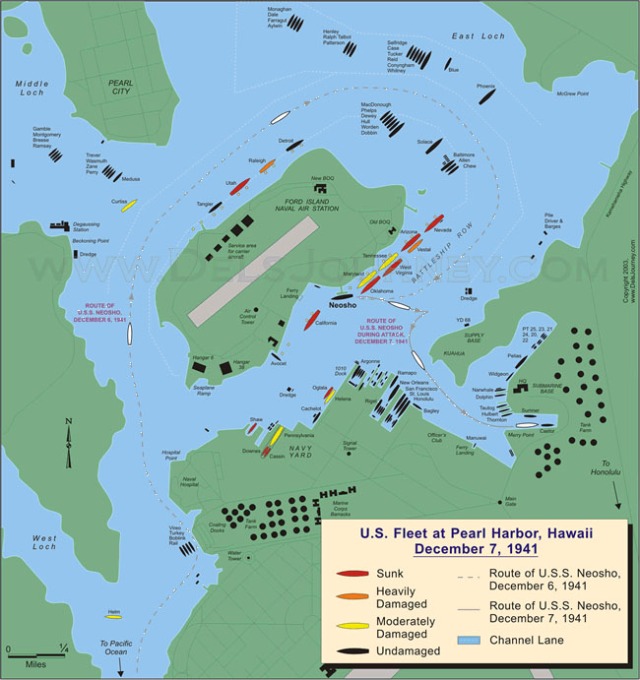REPOSTED from last year.
On December 7, 1941, an event occurred which was horrific in itself, but one that also sealed the fate of the United States to war with Japan.
That sleepy Sunday morning, the attack began as Hawaiians and U.S. military personnel were waking, or were jolted from sleep. The air attack began at 7:48 a.m. Hawaiian Time. As Wikipedia reports it,
Men aboard U.S. ships awoke to the sounds of alarms, bombs exploding, and gunfire, prompting bleary-eyed men to dress as they ran to General Quarters stations. (The famous message, “Air raid Pearl Harbor. This is not drill.”, was sent from the headquarters of Patrol Wing Two, the first senior Hawaiian command to respond.)
The defenders were very unprepared. Ammunition lockers were locked, aircraft parked wingtip to wingtip in the open to prevent sabotage, guns unmanned (none of the Navy’s 5″/38s, only a quarter of its machine guns, and only four of 31 Army batteries got in action).
Despite this low alert status, many American military personnel responded effectively during the attack. Ensign Joe Taussig Jr., aboard Nevada, commanded the ship’s antiaircraft guns and was severely wounded, but continued to be on post. Lt. Commander F. J. Thomas commanded Nevada in the captain’s absence and got her under way until the ship was grounded at 9:10 a.m.
One of the destroyers, USS Aylwin, got underway with only four officers aboard, all ensigns, none with more than a year’s sea duty; she operated at sea for 36 hours before her commanding officer managed to get back aboard.
Captain Mervyn Bennion, commanding West Virginia, led his men until he was cut down by fragments from a bomb which hit Tennessee, moored alongside.
 The attack lasted 90 minutes. Two waves of Japanese aircraft – 353 in all – did their deadly work in such a short time.
The attack lasted 90 minutes. Two waves of Japanese aircraft – 353 in all – did their deadly work in such a short time.
2,008 sailors were killed and 710 others wounded; 218 soldiers and airmen (who were part of the Army until the independent U.S. Air Force was formed in 1947) were killed and 364 wounded; 109 marines were killed and 69 wounded; and 68 civilians were killed and 35 wounded. In total, 2,403 Americans died and 1,178 were wounded. Eighteen ships were sunk or run aground, including five battleships. All of the Americans killed or wounded during the attack were non-combatants, given the fact there was no state of war when the attack occurred.
It is said that a third wave of aircraft were ready to mount another attack, but Admiral Nagumo decided against it because he felt that enough damage had been done, and did not want to risk loss of any more Japanese aircraft. If that third wave had been mounted – primarily to destroy fuel depots – the Pacific Fleet would have been much more seriously damaged, both from direct loss of additional craft, and horrific fire and explosions of fuel repositories.
Aftermath of the attack:
BATTLESHIPS
Arizona (Kidd’s flagship): hit by four armor-piercing bombs, exploded; total loss. 1,177 dead.
Oklahoma: hit by five torpedoes, capsized; total loss. 429 dead. Refloated November 1943; capsized and lost while under tow to the mainland May 1947.
West Virginia: hit by two bombs, seven torpedoes, sunk; returned to service July 1944. 106 dead.
California: hit by two bombs, two torpedoes, sunk; returned to service January 1944. 100 dead.
Nevada: hit by six bombs, one torpedo, beached; returned to service October 1942. 60 dead.
Tennessee: hit by two bombs; returned to service February 1942. 5 dead.
Maryland: hit by two bombs; returned to service February 1942. 4 dead (including floatplane pilot shot down).
Pennsylvania (Kimmel’s flagship):[111] in dry dock with Cassin and Downes, hit by one bomb, debris from USS Cassin; remained in service. 9 dead.
EX-BATTLESHIP (target/AA training ship)
Utah: hit by two torpedoes, capsized; total loss. 64 dead.
CRUISERS
Helena: hit by one torpedo; returned to service January 1942. 20 dead.
Raleigh: hit by one torpedo; returned to service February 1942.
Honolulu: Near miss, light damage; remained in service.
DESTROYERS
Cassin: in drydock with Downes and Pennsylvania, hit by one bomb, burned; returned to service February 1944.
Downes: in drydock with Cassin and Pennsylvania, caught fire from Cassin, burned; returned to service November 1943.
Shaw: hit by three bombs; returned to service June 1942.
AUXILIARIES
Oglala (minelayer): Damaged by torpedo hit on Helena, capsized; returned to service (as engine-repair ship) February 1944.
Vestal (repair ship): hit by two bombs, blast and fire from Arizona, beached; returned to service by August 1942.
Curtiss (seaplane tender): hit by one bomb, one crashed Japanese aircraft; returned to service January 1942. 19 dead.
In the wake of the attack, 15 Medals of Honor, 51 Navy Crosses, 53 Silver Stars, four Navy and Marine Corps Medals, one Distinguished Flying Cross, four Distinguished Service Crosses, one Distinguished Service Medal, and three Bronze Star Medals were awarded to the American servicemen who distinguished themselves in combat at Pearl Harbor.[116] Additionally, a special military award, the Pearl Harbor Commemorative Medal, was later authorized for all military veterans of the attack.
The day after the attack, Roosevelt delivered his famous Infamy Speech to a Joint Session of Congress, calling for a formal declaration of war on the Empire of Japan. Congress obliged his request less than an hour later. On December 11, Germany and Italy, honoring their commitments under the Tripartite Pact, declared war on the United States. The pact was an earlier agreement between Germany, Italy and Japan which had the principal objective of limiting U.S. intervention in any conflicts involving the three nations.[117] Congress issued a declaration of war against Germany and Italy later that same day. The UK actually declared war on Japan nine hours before the U.S. did, partially due to Japanese attacks on Malaya, Singapore and Hong Kong, and partially due to Winston Churchill’s promise to declare war “within the hour” of a Japanese attack on the United States.






And now the Japanese are up in the top five investors in the island buying real estate hand over fist. My how times have changed.
LikeLiked by 4 people
Of coarse, I as thought FDR knew….
LikeLiked by 1 person
I particularly like FDR’s refusals to believe Uncle Joe murdered more Ukrainians in one year that Hitler did Jews in some eight years. FDR also refused to believe the reports from reliable sources that Hitler had signed a secret protocol with Stalin on how to divide up Europe and the reports that Hitler and Stalin jointly attacked Finland and that Stalin had given Hitler the Russian base at Murmansk to use as a launching pad for the German invasion of Norway,.
Sorta makes you wonder whose side FDR was on.
LikeLiked by 1 person
Pearl Harbor should serve as a warning that our enemies will use any opportunity to attack if they suspect we are weak or lack resolve. 9-11 demonstrates that.
LikeLiked by 3 people
Churchill promised to declare war within the hour of a Japanese attack on the US and honored his promise.
These days, Theresa May offers safe haven to the enemy in her own country and gets her panties in a wad over our President’s truthful tweets.
God rest the souls lost that day.
LikeLiked by 5 people
Good to see you, Lburg. 👋🏻👋🏻👋🏻
LikeLike
Tara Ross’ column about the Pearl Harbor attack. Very interesting, with background:
http://www.taraross.com/2017/12/this-day-in-history-pearl-harbor/
LikeLiked by 4 people
Yes, stella. We WILL remember. Thank you so much for this…..will have to take time to absorb all the details in your post a little later but am so glad you posted this.
LikeLiked by 5 people
The US wasn’t without warning this would happen. In 1924 Billy Mitchell was sent on a tour of Asia that included Japan. Mitchell, if you remember, was no stranger to airpower as he demonstrated to a disbelieving US Navy how aircraft could sink battleships, so he was very interested in Japan’s use of airpower. When he returned and wrote his report in 1925 he predicted Japan would attack Pearl Harbor with naval aircraft and bomb it to damage US naval power in the Pacific.
The Japanese knew they had a problem in attacking Pearl. The battleships had belts of special steel armor over a foot thick to minimize torpedo damage. They also had internal sloped deck armor to blunt what might get through the belt and a specially designed double hull to protect against a torpedo exploding under the ship in an attempt to break its ‘spine’. There was also deck armor to protect against an aerial hit and extra armor around the magazines. These battleship decks were tested and meant to resist hits by aerial bombs with large explosive loads and the Japanese didn’t have armor piercing bombs their planes could carry. Limited to the 400ish planes the six Japanese carriers could hold, the multiple missions they had, the distance in and out they had to fly and unsure how many would make it to their targets the Japanese had to improvise to ensure success. What to do, what to do? Some smart cookie looked at the problem, thought about it and came up with a brilliant solution. He put wooden fins on a naval armor piercing artillery shell and used it as a bomb. It worked, and naval aircraft bombed the US battleships with naval artillery shells dropped from a plane.
I agree that the biggest mistake the Japanese made was not destroying the submarines and their associated support facilities and the biggest break the US had was its three aircraft carriers, the Enterprise, Lexington and Saratoga, were at sea. In June of 1942 the US caught the Japanese at the Battle of Midway and the US sunk four of the six Japanese aircraft carriers that attacked Pearl Harbor and one of the US carriers participating was the Enterprise. A little over two years later the remaining two Japanese carriers that attacked Pearl were sunk by US submarines in two separate actions.
LikeLiked by 6 people
Read the Tara Ross piece, which covers the history.
LikeLiked by 3 people
I did – thought my piece was filler. She says four Japanese carriers participated but there were six: Akagi, Kaga, Soryu, Hiryu, Shokaku and Zuikaku. The first four were sunk at the Battle of Midway, the last two in June and October of 1944 by submarines. The Japanese records show that just over 400 aircraft were launched while she has a lesser figure…fog of war.
LikeLiked by 6 people
The US had also broken the Japanese Army, Navy and diplomatic codes well before December, 1941, and had decrypted the Japanese DC embassy’s instructions to break off relations with the US but bureaucratic bungling prevented its getting to the proper authorities who might have been able to warn Pearl and maybe blunt the attack.
LikeLiked by 4 people
Sorry if I misunderstood.
LikeLiked by 2 people
Same here
LikeLiked by 2 people
Some of us, because of the families we came from, remember a bit more as we lived in a WWII vet environment. Soon we’ll all be gone and nothing but revisionist historians born a generation or more after Vietnam will be telling WWII history.
LikeLiked by 5 people
Heartbreaking isn’t it?
LikeLiked by 3 people
Yeah, but various organizations will keep on telling the truth. I have some US history books from the John Birch library that I’ll use to buffer my GS and GGS’s school indoctrination.
LikeLiked by 3 people
On point!!!!!!
LikeLiked by 3 people
Czar, Stella well done!!!!! Have been too the Arizona Memorial, many times. Last time in ’05 to see the Mo (USS Missouri). …..
LikeLiked by 6 people
Two vids from the Marines YouTube Channel…
Imperial Japan Attacks! | December 7, 1941
76th Anniversary of Pearl Harbor
LikeLiked by 3 people